
About UsThe Numismatic Bibliomania Society is a non-profit organization promoting numismatic literature. For more information please see our web site at coinbooks.org SubscriptionsThose wishing to become new E-Sylum subscribers (or wishing to Unsubscribe) can go to the following web page link MembershipThere is a membership application available on the web site Membership Application To join, print the application and return it with your check to the address printed on the application. Membership is only $15 to addresses in the U.S., $20 for First Class mail, and $25 elsewhere. For those without web access, write to: David M. Sundman, Secretary/TreasurerNumismatic Bibliomania
Society AsylumFor Asylum mailing address changes and other membership questions, contact David at this email address: dsundman@LittletonCoin.com SubmissionsTo submit items for publication in The E-Sylum, just Reply to this message, or write to the Editor at this address: whomren@coinlibrary.com
BUY THE BOOK BEFORE THE COINYou won't regret it! |
- WAYNE'S WORDS: THE E-SYLUM NOVEMBER 16, 2008
- LAKE BOOKS SALE #95 PRICES REALIZED AVAILABLE
- NOBLE NOVEMBER 2008 SALE FEATURES NUMISMATIC LIBRARIES
- MORE ON KOLBE NUMISMATIC LITERATURE SALES #107 AND #108
- NEW BOOK: FIAT PAPER MONEY (2ND EDITION) BY RALPH FOSTER
- NEW BOOK: HANDBOOK OF 20TH CENTURY U.S. GOLD BY DAVID AKERS
- NEW EDITION: COINS OF ENGLAND AND THE UNITED KINGDOM 2009
- STELLA NUMISMATIC WEB SITE LAUNCHED
- MYSTERY OF GRAMERCY COIN BOARDS SOLVED
- QUICK QUIZ: NAME THOSE TUNES ON THE DISTRICT OF COLUMBIA SCRIP NOTES
- ON THE PEDIGREE OF THE 1844-O EAGLE
- MORE ON ALEXANDRE VATTEMARE
- MORE ON THE OHIO CASH HOARD
- DICK JOHNSON REVIEWS THE U.S. MINT'S GIFT CATALOG
- MORE ON GRUMPY DEALERS
- A GRUMPY NUMISMATIC NEWS READER
- ON FLOWERY PROSE IN EBAY COMMENTS
- QUERY: SOURCES FOR NEW ADAMS-WOODIN NUMBERS SOUGHT
- ANS LETTERPRESS PRINTING BLOCKS FOR SALE
- MORE HIDDEN LONGACRE DOODLING?
- WILLARD WIGAN: THE WORLD'S TINIEST SCULPTURES
- SCOTT SEMANS' ADVICE TO NUMISMATIC AUTHORS
- ARIZONA TOKEN BOOK AUTHOR HALDEN BIRT, JR.
- WAYNE'S NUMISMATIC DIARY NOVEMBER 11, 2008
- THE CASE OF THE LOST VOYAGEUR: CANADA'S MISSING DOLLAR DIES
- WILL MICHAELMAS FAIR COIN TOSS BE BANNED?
- PLATTE WOODS MUSEUM SCALE COLLECTION INCLUDES COIN SCALES
- AMBASSADORS OF ALOHA: HAWAII'S STATE QUARTER RELEASED
- RECOVERY OF STOLEN MEDAL REUNITES MAN WITH HIS ANCESTRY
- EERIE COINCIDENCE AS MAN FINDS MEDAL HOARD IN GARDEN
- FEATURED WEB SITE: COIN WEIGHTS
WAYNE'S WORDS: THE E-SYLUM NOVEMBER 16, 2008
 Among our recent subscribers are Kevin
Andersen, Alex Siegel, Kyle Knapp, and Brett Telford. Welcome aboard! We
now have 1,219 subscribers.
Among our recent subscribers are Kevin
Andersen, Alex Siegel, Kyle Knapp, and Brett Telford. Welcome aboard! We
now have 1,219 subscribers.Your editor is traveling today for business, so this issue is going out early for a change. We open with notes on numismatic literature sales by Lake, Noble and Kolbe, and announcements of new books on Fiat Money, U.S. gold and the Coins of England. We discuss two mysteries this week, but only one is solved: the case of the missing dollar dies and the mystery of the Gramercy coin boards.
In topics opened in earlier issues, we discuss the 1844-O Eagle, the Ohio cash hoard, grumpy dealers and Arizona token book author Hal Birt. You can probably guess why dancers from Halau Olapakuikalai O Hokuaulani of Kaneohe performed the hula this week, but to learn about the world's smallest sculptures (and see some incredible photos), read on. Have a great week, everyone!
Wayne Homren
Numismatic Bibliomania Society
LAKE BOOKS SALE #95 PRICES REALIZED AVAILABLE
Fred Lake writes:NOBLE NOVEMBER 2008 SALE FEATURES NUMISMATIC LIBRARIES
- 1841-1857 Wright Collection.
- 2740-2803 Tom Hanley Library - General books mostly 30-40 books each lot
- 4242-4300 Tom Hanley Library - Numismatic books mostly bulk lots in each lot with very cheap estimates
- 4301-4327 other numismatic books many as bulk lots.
- 4590-4622 Tom Hanley Library - Military books mostly bulk lots in each lot with very cheap estimates.
To view the catalogue, see: S.89 Important Australian & World Coins, Medals, & Banknotes (http://www.noble.com.au/auctions/browse_cat.php?sale=89)
MORE ON KOLBE NUMISMATIC LITERATURE SALES #107 AND #108
The highlights of two outstanding numismatic libraries are to be sold, both remarkable for their exceptionally fine overall condition. The first 72 page catalogue features 100 lots of rare and classic works on American numismatics, with some fifty full color illustrations. Lots 1-75 are from The Twinleaf Library and lots 76-100 are the property of several additional consignors. The second 108 page catalogue, with over one hundred full color illustrations, is comprised of 175 early printed numismatic books and classic titles on Italian coins and medals from the library of Dr. Ferdinando Bassoli of Turin, Italy, numbered from 101 to 275.
Further information on any of the lots that follow may be found in the two catalogues, both of which are accessible at our web site.
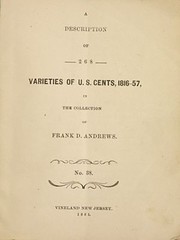 Lot 1 is an extremely rare original 1881 Frank
Andrews work on U. S. Cents, 1816-57, one of only forty copies issued and
one of as few as eight to ten copies known to have survived. It is the
first work to cover the later date cents. The estimate is $8,500.
Lot 1 is an extremely rare original 1881 Frank
Andrews work on U. S. Cents, 1816-57, one of only forty copies issued and
one of as few as eight to ten copies known to have survived. It is the
first work to cover the later date cents. The estimate is $8,500.
Lot 41 is S. H. Chapman's Own Superb Plated 1921 J. M. Henderson auction sale catalogue, one of only a half dozen known and perhaps the finest to have survived. The 4 superb photographic plates depict outstanding United States large cents and half cents. The estimate is $12,500.
Lot 88 features the first two works on American medals, published in the 1830s and arranged in a leather-bound volume and annotated by Charles Ira Bushnell, one of America's most famous 19th century numismatists. The estimate is $5,000.
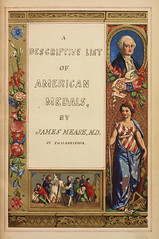
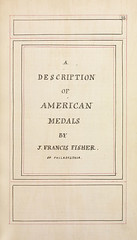
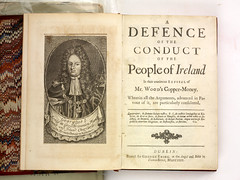 Lot 94 is an extremely rare 1724 work
attributed to Jonathan Swift entitled "A Defence of the Conduct of the
People of Ireland in Their Unanimous Refusal of Mr. Woods Copper Money."
Again, it is from the Bushnell library and is prominently cited in
Crosby's 1875 "Early Coins of America." No institutional copies of this
rare second edition were located. The estimate is $5,000.
Lot 94 is an extremely rare 1724 work
attributed to Jonathan Swift entitled "A Defence of the Conduct of the
People of Ireland in Their Unanimous Refusal of Mr. Woods Copper Money."
Again, it is from the Bushnell library and is prominently cited in
Crosby's 1875 "Early Coins of America." No institutional copies of this
rare second edition were located. The estimate is $5,000. Lot 150 is an outstanding example of Guillaume Du Choul's illustrated 1555 & 1556 works on ancient Roman coins, religion, and military camps, bound in remarkable n armorial leather-bound volume dated 1558. The estimate is $10,000.
Lot 162 is the rare 1524 second edition of the first illustrated numismatic book, Andrea Fulvio's "Illustrium Imagines." Estimate $4,500.
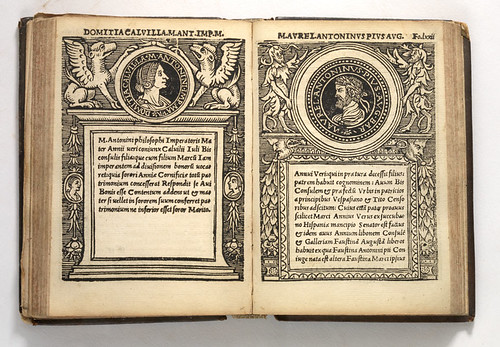
Lot 193 is a remarkable copy of Antoine Le Pois's well-illustrated 1579 work on ancient Greek, Jewish, and Roman coins in a superb French red morocco binding decorated in gilt, executed by one of the most famous Parisian bookbinders of the period. The estimate is $8,500.
Lot 270 is and exceptionally fine set of the most comprehensive work ever written on the coinage of a single country, namely King Victor Emmanuel's monumental twenty folio volume set of "Corpus Nummorum Italicorum," published from 1910 to 1943. Dr. Bassoli's set is remarkable in that it features an original edition of the twentieth volume, a gift from the King's son. This final volume never advanced beyond the "proof" stage and perhaps a dozen or fewer copies are extant today. The estimate is $12,500.
There are many other outstanding books in the two sale catalogues.
NEW BOOK: FIAT PAPER MONEY (2ND EDITION) BY RALPH FOSTER
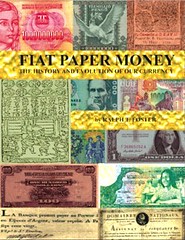 Fiat Paper Money tells the history of the
money in your wallet. From the first paper money issued in China in 1024
A.D., to the billions of currency notes circulating today, a fascinating
legacy unfolds. Read the Preface. This new book weaves first-hand accounts
of merchants, travelers, and explorers with banks, governments and
nations. Fiat Paper Money provides a depth of research into a little known
subject.
Fiat Paper Money tells the history of the
money in your wallet. From the first paper money issued in China in 1024
A.D., to the billions of currency notes circulating today, a fascinating
legacy unfolds. Read the Preface. This new book weaves first-hand accounts
of merchants, travelers, and explorers with banks, governments and
nations. Fiat Paper Money provides a depth of research into a little known
subject.Our money today is the product of an abrupt change that happened less than four decades ago. It was then that the world's currencies all became fiat: backed only by laws and policies, and subject to change at any time.
My mother was shocked when her favorite restaurant raised the price of coffee from 5 to 10 a cup in the late 1960s. Coffee had cost a nickel for decades, but suddenly everything was becoming more expensive. Yet she never questioned her money. She didn't know it was losing value.
Fiat money inevitably loses value over time. In the centuries since paper money was invented, governments have often exercised fiat to arbitrarily set the value of money, with the same disastrous consequences. Empires collapsed and countless individuals were ruined when that paper money failed to buy what they needed.
This book tells their stories. It gives the facts about how, why, and when fiat money changes. The responsibility to understand those changes rests with you.
Dr. Ruth S. Arnon Hanham PhD. writes:
Donald E. Smith Professor of Physics College of Southern Maryland writes:
For more information, see: FIAT PAPER MONEY (http://home.pacbell.net/tfdf/)
NEW BOOK: HANDBOOK OF 20TH CENTURY U.S. GOLD BY DAVID AKERS
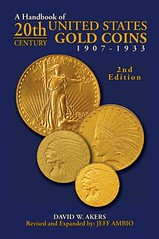 David W Akers classic numismatic reference, A
Handbook of 20th-Century U.S. Gold: 1907-1933, first published in 1988, is
now available in an updated second edition published by Zyrus Press!
Revised and expanded by Jeff Ambio, author of the Strategy Guide Series,
he begins the book by describing the changes in the market since the
publication of the first edition. He says,
David W Akers classic numismatic reference, A
Handbook of 20th-Century U.S. Gold: 1907-1933, first published in 1988, is
now available in an updated second edition published by Zyrus Press!
Revised and expanded by Jeff Ambio, author of the Strategy Guide Series,
he begins the book by describing the changes in the market since the
publication of the first edition. He says,
However, Ambio also acknowledges that,
At 363 pages, this book follows an easy-to-read layout. Each coin is beautifully illustrated with full color coin images, with their characteristics broken down into strike, luster, color, surfaces, and eye appeal. Significant Examples of each coin, auction appearances to date and prices realized make a debut in this new edition, as well tables for Total Known by Grade and Values by Grade. Rarity and population figures are the latest information you will find and Proof gold coins are a welcome addition to this classic reference.
Look for copies of A Handbook of 20th-Century U.S. Gold Coins in bookstores nationwide, Amazon.com or your local coin shop. Also available from Zyrus Press: PO Box 17810, Irvine, CA 92623. Phone: (888) 622-7823. Web: Stay up-to-date! Visit www.zyruspress.com. E-mail: info@zyruspress.com.
A Handbook of 20th-Century U.S. Gold Coins: 1907-1933 2nd Edition
Published by Zyrus Press, Inc. of Irvine, California (www.zyruspress.com)
Publication Date: November 2008
Binding / Size: Paperback / 6x9
Photos / Illustrations: 150+ full color images
Pages: 363
Suggested Retail Price: $34.95
For more information, see: A Handbook of 20th-Century U.S. Gold Coins: 1907-1933 - 2nd Edition (http://www.zyruspress.com/ahandbookof20th-centuryusgoldcoins1907-1933-2ndedition.aspx)
NEW EDITION: COINS OF ENGLAND AND THE UNITED KINGDOM 2009
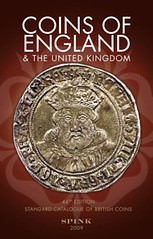 Coins of England and the United Kingdom
remains the only single-volume reference work which features every major
coin type from Celtic to the present day with accurate market values for
every coin type listed. It is an essential guide for beginners, serious
numismatists and anyone interested in British Coinage.
Coins of England and the United Kingdom
remains the only single-volume reference work which features every major
coin type from Celtic to the present day with accurate market values for
every coin type listed. It is an essential guide for beginners, serious
numismatists and anyone interested in British Coinage. As with every new edition, all sections of the catalogue have been carefully checked by the specialists at Spink and the prices of the coins have been updated to reflect current market conditions. The reference numbers used are recognized world-wide and are quoted by all of the leading auction houses and dealers.
PRICED AT 25
Free postage anywhere in the world if you preorder now (retail orders only).
For enquiries and orders please contact Catherine Gathercole: Tel: +44 (0) 20 7563 4046. Fax: +44 (0) 20 7563 4066 or E-mail: books@spink.com
For more information, see: Spink Numismatic Book Department (www.spink.com/departments/books.asp)
THE BOOK BAZARRE
STELLA NUMISMATIC WEB SITE LAUNCHED
 In our first month of operations, we have
published two rare books from our catalog. The first was David Lawrences
anecdotal stories titled, Tales from the Bourse. The second, more
ambitious effort is The Complete Guide to Liberty Seated Half
Dollars by Randy Wiley and Bill Bugert. This amazing book remains the
only standard reference to die varieties of this series and it has been
largely unavailable for over 5 years.
In our first month of operations, we have
published two rare books from our catalog. The first was David Lawrences
anecdotal stories titled, Tales from the Bourse. The second, more
ambitious effort is The Complete Guide to Liberty Seated Half
Dollars by Randy Wiley and Bill Bugert. This amazing book remains the
only standard reference to die varieties of this series and it has been
largely unavailable for over 5 years. Future plans for Stella include as many as 10 more DLRC Press titles and we hope to get other authors to contribute their books as well. As publishers of the Stella site, we encourage as much participation as possible to make this a community forum.
Tales from the Bourse (www.stellacoinnews.com/?page_id=95)
The Complete Guide to Liberty Seated Half Dollars (www.stellacoinnews.com/?page_id=79)
MYSTERY OF GRAMERCY COIN BOARDS SOLVED
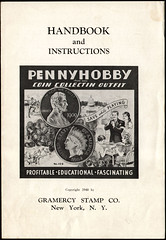 A recent internet auction purchase has solved
the mystery behind the elusive coin collecting boards published by
Gramercy Stamp Company in 1940. A simple, four-page booklet reveals the
reason why this publishers brand of coin boards carry so little
information on them regarding their manufacturer and purpose. These
boards, of which but two titles are known, were originally issued not as
stand-alone items but as part of a boxed coin collecting kit.
A recent internet auction purchase has solved
the mystery behind the elusive coin collecting boards published by
Gramercy Stamp Company in 1940. A simple, four-page booklet reveals the
reason why this publishers brand of coin boards carry so little
information on them regarding their manufacturer and purpose. These
boards, of which but two titles are known, were originally issued not as
stand-alone items but as part of a boxed coin collecting kit.In his book Coin Collecting Boards of the 1930s & 1940s A Complete History, Catalog & Value Guide, board collector and researcher David W. Lange listed these two titles put out by Gramercy Stamp Company and speculated that they may have been included in just such a set. This notion was based on his discovery of a submission made by that business to the United States Copyright Office. Entry number KK 5046 was dated July 17, 1940 and records the delivery for copyright protection of the Pennyhobby Coin Collecting Outfit No. 103. Nothing was stated as to the contents of this item, but Lange reasoned that it likely included the two penny boards listed and illustrated in his book.
Lange recently obtained confirmation of this assumption through his purchase on the internet of a small booklet titled HANDBOOK and INSTRUCTIONS which illustrated the box art for that very same PENNYHOBBY COIN COLLECTING OUTFIT No. 103. This box also carries the notation PROFITABLE EDUCATIONAL FASCINATING, as well as the advice to SAVE while PLAYING. The box features large illustrations of the obverse of an 1864 Indian Head Cent and a 1909 Lincoln Head Cent, as well as a charming scene of Mom, Dad, Son and Daughter gathered around a card table examining pennies and mounting them in the boards. The inside pages of this booklet describe the contents of the coin collecting kit, while its back page lists the average prices dealers would pay at the time for Eagle, Indian and Lincoln Cents. This sort of information typically is found on coin boards, but its inclusion on a separate instruction guide explains the minimal text seen on the actual Gramercy boards.
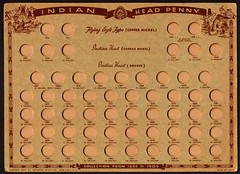

Also found on the box cover are a collage of cents, as well as the very same line drawings which appear on the coin boards themselves. Included is an illustration of the young Abe Lincoln splitting rails and a Native American on horseback riding past a cluster of teepees. Another image is that of the U. S. Capitol building as seen on the Gramercy board for Lincoln Cents. These two coin boards are unique in that they are in landscape, or horizontal, orientation.
While the acquisition of this rare piece of ephemera has proved that the two Gramercy Stamp Company coin boards were indeed issued as part of a boxed coin collecting kit, the set itself has still not surfaced. So rare are the Gramercy brand boards that Lange has seen only four in 25 years of collecting antique coin boards. He is very interested in obtaining additional pieces, as well as the complete boxed set.
David W. Lange buys and sells old coin boards, as well as offering his book on the subject. He puts out newsletters and price lists regularly. His website devoted to coin boards is www.coincollectingboards.net. He may be contacted at David W. Lange, POB 110022, Lakewood Ranch, FL 34211-0022, by email at langedw@msn.com and by telephone at 941-586-8670.
QUICK QUIZ: NAME THOSE TUNES ON THE DISTRICT OF COLUMBIA SCRIP NOTES
Regarding the musical scale printed on the 1837 District of Columbia scrip note pictured in last week's review of Richard Doty's America's Money, America's Story, Arthur Shippee writes:
ON THE PEDIGREE OF THE 1844-O EAGLE
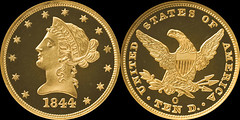 Saul Teichman writes:
Saul Teichman writes:
It was listed as lot 1263 and sold to Virgil Brand for only $50 and was entered into the Brand journal as #57068. The coin was not appreciated then as other gold proof eagles purchased at the time brought the prices shown below:
1838 proof $10 lot 1201 $200 Journal id - 57063
1843 proof $10 lot 1203 $100 Journal id - 57065
1848 proof $10 lot 1213 $100 Journal id - 57066 later to Pittman
1858 proof $10 lot 1223 $102.50 Journal id - 57067 same price as Jewett coin (this could also be the Jewett coin)
As most bibliophiles know, Woodin kept his half eagles which I believe were sold to Newcomer in the mid-1920s thus the 1844-O half eagle has a different pedigree.
MORE ON ALEXANDRE VATTEMARE
Regarding last week's item mentioning John Kraljevich's European visit and viewing of the Vattemare collection, Pete Smith writes:Actually, that was a portrait of Vattemare, found on the Boston Public Library web site:
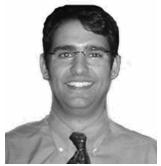
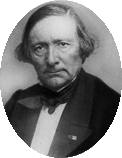
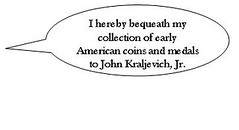
MORE ON THE OHIO CASH HOARD
Regarding the 2006 cash hoard discovered in the Cleveland area, I wrote:The hoard contained $182,000 face value of "Depression-era" U.S. paper money. When the owner of the home and the contractor who found the hoard hidden behind a wall couldn't agree on how to divide the treasure, the deal fell apart.
Myron Xenos writes:
To answer your question, I wanted to have the bills certified, given a hoard name, and sold in that method. People will definitely pay more for an item which has an interesting story attached. I know I would have liked a certified piece of D.B. Cooper money.
The whole situation is really unfortunate. There would have been big 6-figure money involved and I am sure some of the notes got damaged. I have never heard of any of the bills surfacing, so I guess this is not the end of the story.
Bob Neale forwarded this image from the Star-News. He writes:
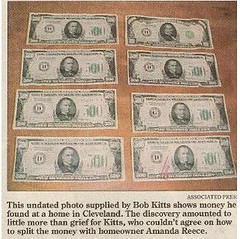
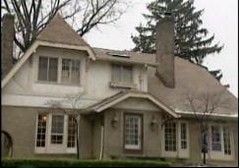 Amanda Reece had planned on sinking money into
her nearly 90-year-old house, not pulling money out.
Amanda Reece had planned on sinking money into
her nearly 90-year-old house, not pulling money out. It was more of a fixer-upper than I thought, Reece told CBS News correspondent Cynthia Bowers.
 So, imagine her surprise when her contractor,
Bob Kitts, called to say he'd found a hidden treasure - inside the
bathroom wall.
So, imagine her surprise when her contractor,
Bob Kitts, called to say he'd found a hidden treasure - inside the
bathroom wall. I open up one of the envelopes, tear open the corner and there's a $50 bill. I thought I was going to pass out, Kitts said.
The total? One hundred and eighty-two thousand dollars, many of them rare bills dating from 1929, worth an estimated half-million dollars.
To view the CBS video, see: "Finders, Keepers" For Hidden Treasure? (http://www.cbsnews.com/stories/2007/12/13/eveningnews/main3617369.shtml)
DICK JOHNSON REVIEWS THE U.S. MINT'S GIFT CATALOG
- Best Bargain Award in my mind is the 2008 Uncirculated coin set of 28 coins ($13.82 face) for only $9.13 voguish above face (page 5, item UD8). Includes five denominations from two mints with all the State quarters and President dollars issued in the current year. Really! 28 different coins!
- Most Dramatic Award is the illustration for the Saint-Gaudens double eagle in double thickness in double high relief which will be offered in 2009. At double the price of gold? Can't say yet. "Price to be determined." (All precious metal items are not priced, call or visit website.)
- Just Learned The Terms Award goes to Director Edmund C. Moy, who defined the terms "proof" and "uncirculated" for us in his letter shown on page 2. Just learned what these meant, Ed?
- Most Popular Coin Shown Award is Fraser's Indian and bison design which is shown 27 times on pages 6 and 7. In gold.
- Photo Accessory Award goes to the photographer of page 12/13 who shows a Bureau of the Mint bag of 1906 along with a plaster model Andrew Jackson's dollar coin obverse of 1908. Please don't start collecting Mint bags (or ordering this one) -- the Mint is trying to sell 2008 Presidential coins.
- Stretching the Last Possible Profit Award goes to the Mint's sales department for offering State quarters in philatellic-numismatic covers or with statehood stamps, or with mashed dies that struck the quarters in the first place. (Next year's offer: genuine cufflink of the State's Governor with each State quarter.)
MORE ON GRUMPY DEALERS
Regarding our discussions on grumpy book and coin dealers, Bruce Smith writes:At first I worked on the Standard Catalog of World Coins, but when that edition was finished, I was assigned to World Coin News. My title was Editorial Assistant, but at that time the entire staff of WCN was Russ Rulau and myself, so I have often fudged a bit and said I was assistant editor.
One day Russ asked me what I collected. I told him I collected Chinese coins. He then asked, "What else?" in a tone which suggested there should be another answer. I didn't really collect anything else at that time, but in thinking about it later, I realized I was interested in Missouri obsolete paper money, though it was too rare for me to collect.
I decided to collect Missouri bank checks. This led to Missouri tokens and Missouri post cards, and I realized I was homesick and didn't know much about Missouri history. I began buying books on the subject.
On one of my trips to St. Louis, I visited the usual used bookstores on Delmar and Aamitin's downtown, but I noticed another used bookstore in phonebook, on DeMun, near Washington University. I drove out there and found a small but well-stocked book store in an out-of-the-way area. I selected a pile of books, took them to the counter where they were totaled.
As I was paying for them, the owner noticed my Wisconsin drivers license. He informed me he could not sell the books to me because I was from out-of-state. It didn't matter whether I wanted to pay with cash, check or credit card, he would not sell me the books because he said he only sold books about Missouri to people who lived in Missouri. It didn't matter that I had lived the first 25 years of my life in St. Louis, nor that I was interested in researching Missouri history -- he would not sell me the books.
He explained that California book dealers would buy Missouri books from him and sell them out west where they would not be available to Missouri residents. When he had refused to sell to California book dealers, they sent "agents" to secretly buy his books! I left, with my pile of books sitting on his counter, and have never been back. To my surprise, he is still in business today.
In the 1930's and 1940's (before my time), the stamp business in New York was centered on Nassau Street, mostly in one multi-storied building, which was full of stamp dealers. Stamp dealers seem to be even more eccentric than coin dealers. One prominent dealer in the building had a sign on his door which read: "State your business and get out."
Joe Boling writes:
In the summer of 1976 I was driving across the country visiting friends, relatives, and dealers on my way to Fort Harrison (Indianapolis) for a 13-week school. I had been buying Japanese coins from Almanzar's in San Antonio for several years, so I wanted to drop in there (among several other shops in SA). I finally got there early one afternoon and asked to see their world paper money, emphasizing Asia (by that time my type set of Japanese coins had been completed).
I was told that they had a fair quantity of foreign paper money, but that they didn't have time to show it to me. I reminded them that their principal stock in trade was Latin American material, and that they never listed nor auctioned the kinds of notes I was interested in; if they were ever to sell them, it would have to be across the counter in their shop, and I was there as a ready buyer.
They still insisted that they did not have time to show me their carton of world notes. I asked why, as there were obviously a couple of clerks in the shop, in addition to other staff in the back room working on an auction. The response was that someone would have to sit with me while I went through the box, and they could not afford to dedicate a clerk to me for that purpose. I asked what it would take to hire a clerk to watch me; the answer was $20 an hour. I said OK, bring out the box and assign a clerk; here was my first $20.
I spent almost two hours going through that box, and found the following items that I can still recall and identify:
- the first known violet Malaya $100 note (SB2178b) in AU, $3 (there are now 3-4 known) [and eight years later, only 3-4 more]
- a counterfeit Central Reserve Bank of China 500 yuan note (SB1241aq), the first I had seen, in XF for $2.50
- a Japanese military ten yen note (SB2011) with rubber stamps on the back of Lawrence P. Hoseman, whoever he is (F, 75 cents)
- a Japanese military five yen note (SB2025) with odd vermilion and ink characters stamped and written on it (I still have not figured out their significance), VG for 30 cents
The total invoice reads:
A GRUMPY NUMISMATIC NEWS READER
It was filled with commentary from the numismatic industrys leaders as well as from readers.
The cover date is Nov. 14. That is three days after the prior regular issue and four days before the following regular issue. It is an extra issue.
I received a phone call Wednesday from an upset caller. He wanted to tell me in no uncertain terms that he had canceled his subscription because we had completely changed Numismatic News.
I told him we hadnt completely changed the paper and asked him what was the date of the issue that he was referring to. I thought I knew what he would tell me and I was correct in this.
When he told me, I said indeed this particular issue was different, but it was a special extra issue.
That didnt stop him.
To read the complete blog item, see: Extra hassle from extra issue (http://blog.numismaticnews.net/buzz/Extra+
Hassle+From+Extra+Issue.aspx)
ON FLOWERY PROSE IN EBAY COMMENTS
Last week Charlie Davis reported receiving the following eBay comments from an Australian buyer:- No tie-less wide lapels or sneakers at this race day. Ermine bindles abundant.
- Stylish duo caught on CCTV but the falcon did not land in the nest!
Colin Pitchfork writes:
The falcon and the nest could be a reference to a horse (I don't follow the races) that was in the race. It may also allude to his purchase not arriving!
As you note his creative writing was probably penned from having imbibed himself and indulgences on that day (wine or other beverages with a high alcohol content).
I hope this helps Charlie. Not all writers resort to poetic prose in giving a positive response on eBay.
QUERY: SOURCES FOR NEW ADAMS-WOODIN NUMBERS SOUGHT
Regarding numbers designating U.S. patterns assigned after the publication of the Adams-Woodin book on the topic, Alan Meghrig writes:All of the following are Two Cent patterns
- AW 60A
- AW 415A
- AW 454A
- AW 457A, B, C, D, E, F
- AW 519A, B
- AW 520A
- AW 638A
- Any additional new AW numbers for Two-Cent patterns.
ANS LETTERPRESS PRINTING BLOCKS FOR SALE
George Cuhaj is offering on eBay this week some interesting items relating to American Numismatic Society publications. They are letterpress half-tone (screened dot image) copper acid-etched plates depicting society medals and logos. George writes: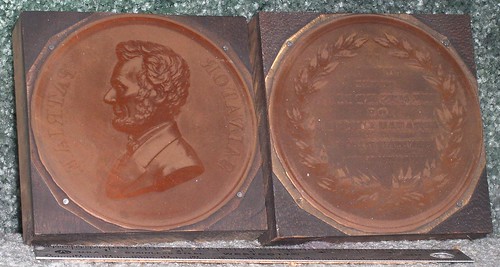


To view George's lots for sale on eBay, see: Items for Sale (http://shop.ebay.com/merchant/cuhaj_
W0QQ_nkwZQQ_armrsZ1QQ_fromZQQ_mdoZ)
MORE HIDDEN LONGACRE DOODLING?
R.V. Dewey has been sharing with us close-up images of coins in which he sees figures and faces he believes were placed there purposely by engravers, particularly James Longacre. R.V. writes:My dear Mr. Zerbe,
It is mighty hard for me to express my sentiments with reference to the initials on the cent. The name of the artist on a coin is essential for the student of History, as it enables him to trace environments and conditions of the time said coin was produced.
R.V. forwarded the following image from the reverse of the 1855 Flying Eagle cent pattern J-171A he calls Witch Eye(TM).
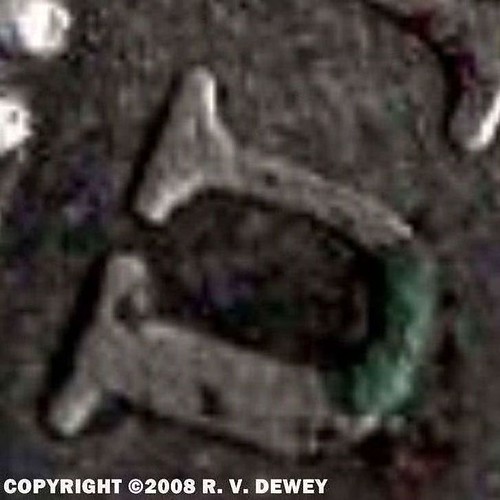
R.V. writes:
Take your time and view this image from several different angles. Increase the brightness on your monitor. Image shifting and camouflage abound! You may view this image at 90,180 and 270 degree rotations. Enjoy!
R.V. adds:
WILLARD WIGAN: THE WORLD'S TINIEST SCULPTURES
Last week we discussed "The World's Smallest Engravings". This week R.V. Dewey forwarded an ABC News segment about the world's smallest sculptures, created by an amazingly talented gentleman named Willard Wigan in Birmingham, England.R.V. writes:
From the web page:
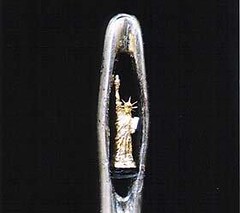
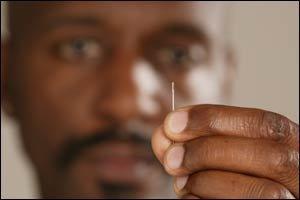
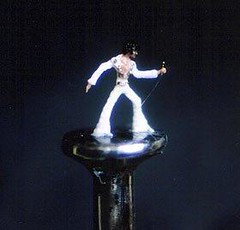
To view the video, see: Art in the Eye of a Needle (http://www.maniacworld.com/art-in-th-eye-of-a-needle.html)
The hoaxbusting web site Snopes says Wigan is the real McCoy. The following was taken from Wigan's web site.
Willard can create a masterpiece within the eye of a tiny sewing needle, on the head of a pin, the tip of an eyelash or a grain of sand. Some are many times smaller than the fullstop at the end of this sentence.
Many are even smaller still, with some being completely invisible to the naked eye yet, when viewed through high power magnification, the effect on the viewer is truly mesmerising.
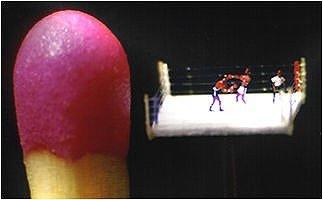
He works in total solitude at a quiet retreat in Jersey mainly at night when there is a greater sense of peace in the world and less static electricity to interfere with the immeasurable precision and tolerances required to create the pieces.

The smallest sculptures can only be measured in thousandths of an inch which is why they can sit, very delicately, on a human hair three thousandths of an inch thick. When working on this scale he slows his heartbeat and his breathing dramatically through meditation and attempts to harmonise his mind, body and soul with the Creator. He then sculpts or paints at the centrepoint between heartbeats for total stillness of hand. He likens this process to "trying to pass a pin through a bubble without bursting it." His concentration is intense when working like this and he feels mentally and physically drained at the end of it.
To read the complete Snopes article, see: Microscopic Art (http://www.snopes.com/photos/arts/microscopic.asp)
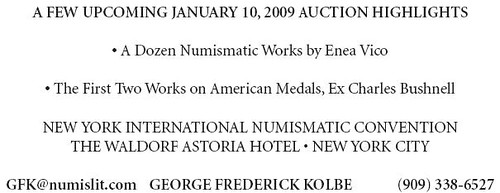
SCOTT SEMANS' ADVICE TO NUMISMATIC AUTHORS
My comments are directed mainly at authors of specialized catalogs, rather than works in economic or numismatic history, or omnibus catalogs such as the SCWC, though the latter will be invoked as example due to familiarity and to the spotlight cast by Krause's recent global change in certain format elements.
Three general observations: 1) Authors generally write with other specialists in mind, not realizing that generalists or complete outsiders account for 90% of the sales of their works. Simpler is better. 2) A good numbering system is important to the acceptance of a new catalog. It is not an afterthought; it can make or break a work. Simpler is better. 3) Seek detailed advice from collectors, dealers, and publishers during the production of your work.
Users of numismatic references generally want these elements: Historical (brief) and numismatic (more) background information; a catalog that is comprehensive by type and more detailed by variety than earlier works, well-illustrated, with a numbering system and valuations. A finding list if the material requires it.
A good layout makes it easy for the user to pluck information from a reference and move on, which is what the vast majority of users want to do. My own preference is for works which make full use of font variations such as separate fonts, bolding, and sizing, and positional elements such as indentation and centering - to whatever extent the complexity of the subject mandates. Columns or even a gridded table will ease the eye's burden for listings which include a large number of specs. It is also important to repeat category headings with each double page spread.
As collector and institutional websites themselves evolve toward catalogs and authors make choices based on translation from print to web or vice versa, bear in mind that desktop publishing programs are much more versatile than the crude and still evolving HTML language in creating eye-friendly layouts. An online catalog's advantages include low cost and ease of update, while a printed catalog's include more universal access, ease of use, ease of comparison (object to image), and permanence. Not considered here, but a useful topic, would be the ease of translation to online format of various print formats, and conversely, ways of designing online catalogs to facilitate compact printouts with satisfactory graphics.
There is rarely any profit in publishing a specialized numismatic work. Finding a publisher, or a printer, are essay-length topics themselves. I could mention one or two firms to avoid because they do not work well with dealers or get good distribution. I am impressed by a print-on-demand service with outlets in Europe and North America, such as Trafford Publishing.
People DO judge a book by its cover; don't economize here. Use a bold, color graphic and preferably a color background, even if it means color photocopying on card stock.
To read the complete article, see: ADVICE TO NUMISMATIC AUTHORS (www.coincoin.com/I018.htm)
ARIZONA TOKEN BOOK AUTHOR HALDEN BIRT, JR.
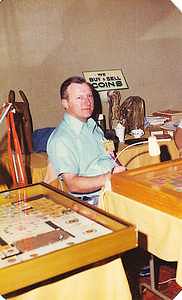 Halden Birt Jr. never outgrew his childhood
hobby. He began collecting coins when he was a boy growing up on an
Illinois farm, and turned his interest into a career.
Halden Birt Jr. never outgrew his childhood
hobby. He began collecting coins when he was a boy growing up on an
Illinois farm, and turned his interest into a career.Birt was an acclaimed numismatist who was tapped by the FBI to testify in court cases involving valuable coins, and he developed a method still in use today for determining the authenticity of rare coins.
In Tucson, he operated Glass Shoppe Coins at 4325 E. Broadway for 45 years, until his death Aug. 30 from congestive heart failure. He was 78. Birt's younger sister, Beverly Knox, remembers young Halden and their father going to the bank every Friday for a new batch of coins through which to sort. Birt started out collecting Indian head pennies and buffalo nickels. Sometimes he let his little sister help him look for those he needed for his collection.
"I'd go to his shop and spend hours, and he'd always be there teaching," Spooner said. "The thing about Hal Birt that's fascinating is, he never looked down on anybody. He was fascinated by what you had to offer. He always wanted to learn and study and find out as much information as he could so he could talk about it. All different aspects of coins fascinated him. When you have someone who has that kind of passion, it rubs off. "He was the grandfather for so many numismatists here in this town," Spooner said. "He was the numismatist's numismatist. He was an absolute student of the hobby and a teacher."
Birt wrote numerous articles and seven self-published books that are still used as reference by coin collectors. The father of two had a special interest in collecting Arizona tokens coinlike pieces made of brass, copper, aluminum or other metal that were offered in trade by businesses, often saloons from the 1880s to 1930s, according to a 1991 Tucson Citizen article about his token collection.
"He thought that Arizona was not appreciated as much as tokens from other states," Tumonis said. "He wanted to put a book out there to introduce collectors to the field of collecting Arizona tokens because there weren't any other books in the field out there when Hal began writing his book."
Birt, a past president of the Tucson Coin Club and longtime member of the American Numismatic Association and the Sociedad Numismatica de Mexico, also was interested in Sonoran coins, tokens and scrip. It was Birt, fellow numismatists say, who first used die stress analysis to determine the authenticity of rare coins, a test that is still used by collectors.
"He was one of the last old-fashioned coin shops in Tucson," Tumonis said. "It's kind of an end of an era. There are other coin shops that are quality establishments, but they don't have the same feel as Hal's did. It's a tremendous loss of knowledge in the numismatic community."
To read the complete article, see: Halden Birt Jr.: He was the king of coins bank on it (http://www.azstarnet.com/metro/260193)
THE BOOK BAZARRE
WAYNE'S NUMISMATIC DIARY NOVEMBER 11, 2008
On Tuesday it was time for the monthly dinner meeting of my Northern Virginia numismatic social club, Nummis Nova. It would be a small gathering this time, since a number of regulars had schedule conflicts this month. But those of us who made it had a special treat - we had our dinner under the same roof as our first President, George Washington.We met at Gadsby's Tavern in Alexandria, VA. John Gadsby operated the hotel and tavern from 1796 to 1808. His establishment was a center of political, business, and social life in early Alexandria. The tavern was the setting for dancing, theatrical and musical performances, and meetings of local organizations. George Washington twice attended the annual Birthnight Ball held there in his honor. Other prominent patrons included John Adams, Thomas Jefferson, James Madison, and the Marquis de Lafayette.
Our host tonight was Bill Eckberg, who lives just a few blocks away, and held his wedding reception in the tavern in 2002. I pulled into a nearby parking space and got out to pump quarters in the meter. A city parking policeman quickly pulled up in a cart and silently waved a finger at me. "Is something wrong?", I asked, figuring I'd unknowingly parked in a handicapped or other restricted spot. He told me to stop feeding the meter - parking was free on holidays, and today was Veteran's Day. So I hung onto my last quarter, thanked him, and crossed the street to the tavern.
As I was reading the historical plaques posted on the walls I was greeted by Tom Kays and David Schenkman. As we walked in, Tom recognized the bartender and hostess, whom he knew from their time working at another local restaurant. It was like walking into Cheers with Norm Peterson - everyone knew his name.
We were directed to our table in a quiet back room where Bill was already waiting. There would only be the four of us, but we had a wonderful time sharing dinner and numismatic discussion. I ordered the Surrey County Peanut Soup and Jumbo Crab Cakes.
Bill told us about the lute player who once appeared regularly at the tavern. He dressed in period garb and would converse with diners about current events - of two hundred years ago to the day. Music continued to be a topic. Dave, who operates a banjo business, told about setting up at the Nashville Bluegrass Show and meeting Red Henry, a mandolin player. Red is active in the Early American Coppers Society, but Dave first knew him only as a musician, not a numismatist. Dave remembered times when as a child, his father's friend Victor Borge would stop by the house to play piano and trade jokes.
Dave told us about how he got started in the coin business. He had been a collector at a young age, but put all his coins in his father's safe deposit box before going off to military service. After returning he'd forgotten about the coins until his dad asked when he was going to get them out of his box. Dave had acquired a number of things he no longer was interested in keeping, so he began selling. Luckily, he'd made some good buys, including rolls of 1931-S and a roll of 1955 Doubled Die cents, which had appreciated in value while he was away.
Discussion turned to Alexandria coin dealer Gene Brandenburg of the Old Town Coin Exchange on King Street. Dave had purchased coins from him, as had Bill, who bought from Gene what became the first coin in his U.S. half cent collection. In other reminiscences, Dave told about buying Sutler notes from the Grover Criswell collection sale at an American Numismatic Association convention auction, and making a trade with former ANA general counsel Ellis Edlow (Civil War Tokens for the Fuld Virginia token collection).
Our theme for the evening was "coins of Presidents born in Virginia". Dave and I had nothing, and our host Bill could only offer one of the new dollar coins of Madison. But as always, Tom Kays came through with a very interesting exhibit. He'd assembled a group of coins dated in the birth year of each Virginia-born American President, including TWO for Washington since the year depends on the choice of Julian or Gregorian calendars (showoff!). By the way, there were eight Presidents born in Virginia:
- George Washington
- Thomas Jefferson
- James Madison
- James Monroe
- William Henry Harrison
- John Tyler
- Zachary Taylor
- Woodrow Wilson
Other great stuff Tom passed around included an 1871 medal by an Alexandria silversmith, a prize for "Perfect Recitation" awarded to Kate W. Duffy by the Mt. Vernon Institute.
Tom gave me a printout of the Colchester Treasure Hunting web site, which is this week's Featured Web Site. I passed around copies of the 1st and 2nd editions of Richard Doty's book, America's Money, America's Story. I quizzed everyone on the musical puzzle in the District of Columbia scrip notes (see the Quick Quiz elsewhere in this issue). Bill Eckberg named one of the tunes, and Dave got the other. Who will be the first to get both?
When it came time for dessert I ordered the Tipsy English Trifle, a sherry-laced pound cake layered with blueberries and vanilla pudding. Yum!
There were two outstanding questions for the evening, both posed by Tom Kays. We were stumped, but perhaps our readers can help:
- Will the exhibits at the new U.S. Capitol Visitor's Center include numismatic items?
- Is there a formal name for the premium placed on precious metal possession? Tom noted the difference between futures prices paid for silver contracts vs actual delivery and possession of the metal.
For more information on Gadsby's Tavern, see: http://oha.alexandriava.gov/gadsby/
THE CASE OF THE LOST VOYAGEUR: CANADA'S MISSING DOLLAR DIES
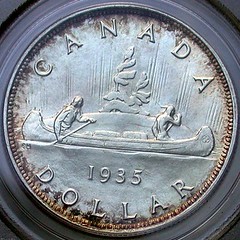 The unsolved and forgotten crime story that
gave birth to the loonie coin two decades ago has been revived by a
retired Mountie who suggests the key to the great Canadian coin caper
could lie hidden somewhere in Ottawa.
The unsolved and forgotten crime story that
gave birth to the loonie coin two decades ago has been revived by a
retired Mountie who suggests the key to the great Canadian coin caper
could lie hidden somewhere in Ottawa.On the morning of Nov. 3, 1986, two freshly engraved master dies for Canada's new $1 coin were picked up by a courier service from the Royal Canadian Mint on Sussex Drive for delivery to the mint's Winnipeg production plant. The mint planned to save $43.50 by sending the dies through a local letter-courier firm instead of a high-security armoured service.
One die carried the image of the Queen and the other noted sculptor and artist Emanuel Hahn's iconic "voyageur canoe" scene that had graced Canada's first silver dollar and other coins since 1935.
The plan was to introduce a new bronze-coloured voyageur canoe dollar coin in early 1987 and begin a two-year phase-out of the old green-and-white $1 bill.
But 11 days later, on Nov. 14, distressed mint officials in Winnipeg called in the Mounties -- the two steel dies had never arrived from Ottawa.
The Winnipeg investigators eventually concluded the dies never arrived there and may have been swiped before they ever left Ottawa, said Mr. Stewart, who retired in 1995 after 35 years of service.
If correct, that means the lost voyageur and its mate may still be floating around the capital. Their resurfacing would be no small change to coin collectors and the Royal Canadian Mint, which is celebrating its 100th anniversary.
"Everybody has a dollar in their pocket, so they can kind of understand this story," said Christine Aqunio, an Ottawa spokeswoman for the mint. "It's one of those urban legends or folklore stories of the mint that everybody likes to talk about. What really happened to those dies?"
As Mounties in Winnipeg and Ottawa tried to answer that question in late 1986, mint officials combed their design bank and selected an image of a loon by artist Robert-Ralph Carmichael. It had been submitted and rejected in 1978 as the image for a $100 gold coin. The substitute design was quickly approved by the federal government.
But for two months, officials said nothing publicly, hoping the lost voyageur and the other die would surface. Before they left the mint in Ottawa, the two dies -- each about eight centimetres square by a few centimetres thick -- were to be packaged separately for shipping, a standard security practice to prevent counterfeiters from getting their hands on a complete set of dies. But they somehow ended up being packaged together in a box clearly marked as mint property.
A week after the dies went missing, mint officials finally informed Monique Vzina, the minister responsible for the mint. For several weeks, Ms. Vzina and mint officials even considered making a minor change to the voyageur design that would enable a police investigation to track down where any counterfeits might be coming from.
That was scrapped when someone decided the public could get burned with the counterfeits in the meantime. People who unknowingly wind up with counterfeit money are required to turn it over to police without any compensation.
On June 30, 1987, six months behind schedule, the first of the bronze-plated nickel dollars went into circulation and 850 million loonies later, the image stands as a ubiquitous Canadian symbol in its own right.
"When you think about it, the loonie is by accident, it was never supposed to be," said Ms. Aquino.
To read the complete article, see: The lost voyageur (http://www.canada.com/ottawacitizen/news/story.html?
id=4cc4a243-3632-49e3-bbb1-5e3008145b36)
WILL MICHAELMAS FAIR COIN TOSS BE BANNED?
Instead, the mayor and councillors of the Cambridgeshire town have been advised to tamely roll the coins towards the scores of kids who line up to scamble for the bounty.
Throughout the history of the event there has only been one freak injury - when someone's glass eye was broken by a coin in the 1940s. Critics branded the warning another example of 'health and safety gone mad', while the Royal Society for the Prevention of Accidents said any ban would be 'over-cautious'.
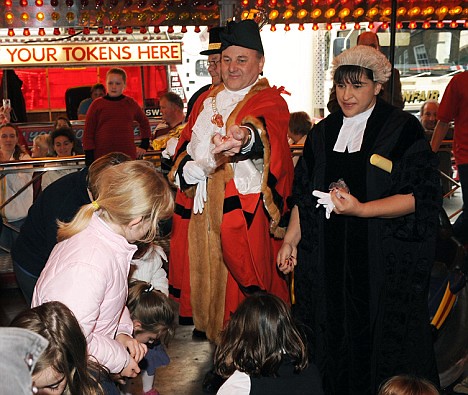
The issue was due to be voted on tonight at a full meeting of the town council, which is dominated by independents, but the mayor indicated members were likely to accept the officers' advice.
'I think it is totally appropriate that at a large public event the council is considering people's safety,' he said. The Michaelmas Fair is a traditional Christian festival which marks the coming of autumn.
In St Ives, the three-day event opens each October with a procession of 16 councillors who parade through the town to the Market Square. Up to 150 local primary school children gather to greet the dignitaries, who then throw new 2p coins from bags they are issued with.
To read the complete article, see: Children's 80-year-old coin throwing tradition to be banned over 'health and safety fears' (www.dailymail.co.uk/news/article-1085081/
Childrens-80-year-old-coin-throwing-tradition-banned-health-safety-fears.html)
PLATTE WOODS MUSEUM SCALE COLLECTION INCLUDES COIN SCALES
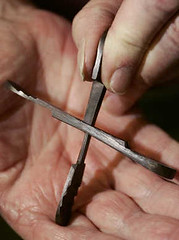 John Schott leads a well-balanced
life.
John Schott leads a well-balanced
life.He has been a collector of scales, weights and measures since 1965, researching their history and reading magazines such as Equilibrium and a Balanced View, both publications of the International Society of Antique Scale Collectors.
His collection of hundreds of scales ranges from those large enough to weigh freight to those small enough to be carried in a pocket. His oldest scale dates to 500 A.D. and was used by Arabs to weigh coins testing the gold content and therefore the coins authenticity.
Recently, Schott moved his collection to Platte Woods and established a museum that is open by appointment.
Schott has hardware scales, including a Howe scale used to weigh nails. It is engineered to use one nail as a balance to measure out 10 nails. Among his collection of baby scales is an unusual 17th or 18th century English one with a wicker basket to hold an infant. Along the walls are large scales and commercial scales that require a penny for weight and 25 cents to tell your fortune. On the shelves are fish scales, coin measures for different denominations, scales used by gold and silver miners and a group of rare toy scales.
Also featured are opium scales from Asia contained in fish- and violin-shaped cases. One even has poppies carved in the top.
Glass-enclosed balance scales were used by pharmacists to dispense medicines.
Schott has a roomful of American and foreign postal scales from the commercial size to the desk type to the pocket varieties, one of which looks like a fountain pen. Its box advertises it as the perfect gift.
To read the complete article, see: Platte Woods museum holds hundreds of scales (www.kansascity.com/news/neighborhood/northland/story/885114.html)
AMBASSADORS OF ALOHA: HAWAII'S STATE QUARTER RELEASED
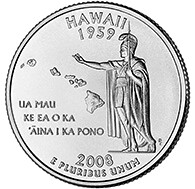 Still reveling in the election of the first
Hawaii-born U.S. president, the islands marked the issuance of its state
quarter the last in the 50-state quarter program.
Still reveling in the election of the first
Hawaii-born U.S. president, the islands marked the issuance of its state
quarter the last in the 50-state quarter program.Hawaii's banks began distributing the quarter Monday to hundreds of coin collectors in lines snaking down Bishop Street, the heart of the downtown business district.
Adults had to buy the coins in $10 rolls, but Gov. Linda Lingle and U.S. Mint Director Ed Roy handed out free coins to children.
"We ask each of you to take the Hawaii quarter with you around the world and be ambassadors of aloha," said Jonathan Johnson, head of the Hawaii State Quarter Commission.
The quarter shows King Kamehameha the Great, the Hawaiian warrior who united the Hawaiian islands under his rule in the early 1800s, standing with his left arm outstretched.
Underneath is a map of the main Hawaiian islands and the state's motto in Hawaiian, "Ua mau ke ea o ka aina I ka pono." The motto translates to "The life of the land is perpetuated in righteousness."
Horner explained the motto means people doing the right thing allows the people and land to endure. "That's a beautiful message of aloha to send out to all of the people in the world," he said.
The design was the overwhelming favorite of the 26,000 people who voted online for their preferred design. Design possibilities that were rejected included a surfer and a hula dancer.
The ceremony had lots of Hawaii flavor: participants wore ceremonial flower leis, and eight elementary school-age dancers from Halau Olapakuikalai O Hokuaulani of Kaneohe performed the hula.
Speakers, including Roy, shouted loud greetings of "aloha" to the crowd.
Last week, much of Hawaii celebrated President-elect Obama's victory. He won 72 percent of the vote in his native state. Only the District of Columbia gave Obama a higher percentage of the vote.
Edmund C. Moy, the U.S. Mint director, said it was bittersweet day because the Hawaii quarter marks the end of the wildly popular 50-state quarter program.
The Mint plans to follow the current program with coins for the District of Columbia and five U.S. territories: Puerto Rico, the U.S. Virgin Islands, Guam, American Samoa and the Northern Mariana Islands.
To read the complete article, see: Hawaii's quarter marks end of nationwide program (ap.google.com/article/ALeqM5j_RwJlhwAfsTd57862i4WYYxGp0wD94CKG100)
Thousands of people lined Bishop Square today to trade in their $10 bills for a roll of new "Hawai'i quarters," which complete the U.S. Mint's 50 State Quarters Program.
People stood in line three abreast for hours today to get their hands on the last quarter in the series, which features a likeness of King Kamehameha I, the island chain and Hawai'i's state motto, "Ua mau ke ea o ka 'aina i ka pono The life of the land is perpetuated in righteousness."
Gov. Linda Lingle and Ed Moy, director of the mint, passed out single quarters to schoolchildren who attended today's launch as adults lined up to exchange their currency into new Hawai'i quarters.

To read the complete article, see: Thousands waited hours in Downtown to get hands on new Hawaii quarter (http://www.honoluluadvertiser.com/apps/pbcs.dll/
article?AID=/20081110/BREAKING01/81110059)
RECOVERY OF STOLEN MEDAL REUNITES MAN WITH HIS ANCESTRY
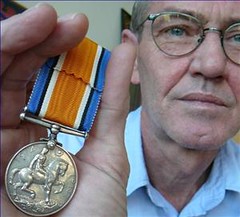 About a week ago, Apsley resident Wally
(Wallace) James opened a Canada Post package and out slipped a First World
War medal, a small token in the palm of his hand linking him to a lineage
he had all but abandoned.
About a week ago, Apsley resident Wally
(Wallace) James opened a Canada Post package and out slipped a First World
War medal, a small token in the palm of his hand linking him to a lineage
he had all but abandoned. The service medal belonged to his great uncle Wallace William James, a black man from Woodstock, Ont. who enlisted in the Central Ontario Regiment in 1917 when he was 21 years old.
It was mid-October when James learned the medal existed, but it took weeks of dealing with a scrupulous seller before it arrived at his mailbox.
It also involved an investigation into his past. James, who has a white mother and black father, had to peal back layers of his genealogy, ultimately reuniting him with a side of his family -- the black side -- that he had been estranged from since childhood, he said.
"I don't believe in spirits, but when this medal slid into my hand, I truly felt I had found my family," the 53-year-old said. "I felt what Wallace William (James) would have felt when he got this in the mail."
On Oct. 11, James got a call from a friend in Woodstock, where James was born and raised, about an article in the Stratford Beacon- Herald. The story was about a rare war medal that had surfaced on EBay inscribed with the name W. W. James.
The source of the article was Dave Thomson, a St. George, Ont. man with an unusual hobby.
Thomson bids on war medals being sold online and tries to reunite them with families or communities.
Since starting his hobby several years ago, Thomson has reunited about 150 veterans' medals with 150 families or communities including matches in North Bay, Beaverton, Sarnia, Kingston, Woodstock and an attempt in Peterborough.
To read the complete article, see: Found my family (www.thepeterboroughexaminer.com/Article
Display.aspx?e=1288878)
EERIE COINCIDENCE AS MAN FINDS MEDAL HOARD IN GARDEN
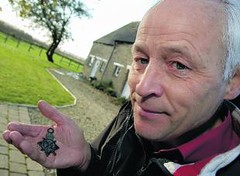 A search for clues about the life of a First
World War soldier has begun after a rare find in a village garden.
A search for clues about the life of a First
World War soldier has begun after a rare find in a village garden.
Medals belonging to Sergeant William Charles Tucker, of the East Lancashire Infantry Regiment, were found in August when thespian Rob Belk was renovating his cottage in Southmoor, near Abingdon.
In a strange coincidence, Kingston Bagpuize Drama Group, based in the neighbouring village, is planning to stage a play about the Accrington Pals a battalion from the same regiment later this month.
The Pals fought on the first day of the Battle of the Somme in 1916, with many of their soldiers dying or suffering terrible injuries.
Mr Belk is planning to create a display about First World War soldiers for the performances on November 27, 28 and 29 in Southmoor village hall and wants to add Sgt Tuckers name to the memorial.
He said: While researching the Accrington Pals, I had a goose-bumps moment when I realised the Elanir notation on the back of the Mons Star I found referred to the East Lancashire Infantry Regiment the same regiment as the Accrington Pals.
To read the complete article, see: Mystery as medal hoard found in garden (http://www.oxfordmail.co.uk/news/3849960.Mystery_as_
medal_hoard_found_in_garden/)
FEATURED WEB SITE: COIN WEIGHTS
This week's featured web site is recommended by Tom Kays.From the web site:
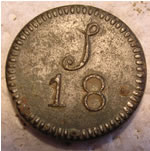 Coin weights were made to correspond to the
weights of particular coin denominations, and the denomination in question
was usually indicated in the design. They were most commonly made of brass
or other copper alloy and were generally produced for high-value pieces,
gold rather than silver coins. Their purpose was to check the weight of
coin in circulation and ensure that coin received was of good quality.
Normally they would correspond to the lowest weight at which the coin
remained legal tender. They could be used to guard against clipped, worn
or counterfeit coin and to check the standards of foreign coin permitted
in currency. For example, weights were provided in England for ducats and
florins in the sixteenth century; for French louis d'or in the late
seventeenth; and for the huge amounts of Portuguese gold in the early
eighteenth
Coin weights were made to correspond to the
weights of particular coin denominations, and the denomination in question
was usually indicated in the design. They were most commonly made of brass
or other copper alloy and were generally produced for high-value pieces,
gold rather than silver coins. Their purpose was to check the weight of
coin in circulation and ensure that coin received was of good quality.
Normally they would correspond to the lowest weight at which the coin
remained legal tender. They could be used to guard against clipped, worn
or counterfeit coin and to check the standards of foreign coin permitted
in currency. For example, weights were provided in England for ducats and
florins in the sixteenth century; for French louis d'or in the late
seventeenth; and for the huge amounts of Portuguese gold in the early
eighteenth www.colchestertreasurehunting.co.uk/C/coinweights.htm
